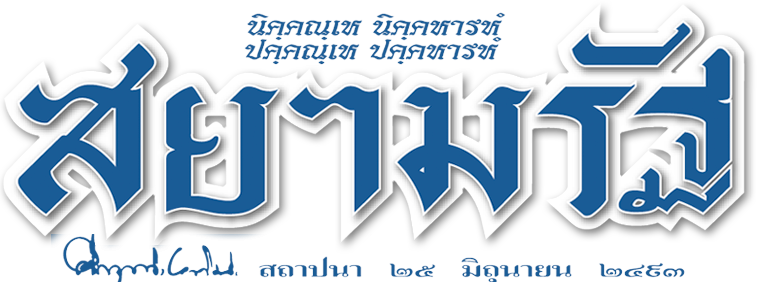ทองแถม นาถจำนง
ในการประชุมวิชาการนานาชาติศิลปะและวัฒนธรรมกับเศรษฐกิจสร้างสรรค์ ครั้งที่ 7 เรื่อง “มรดกชาติพันธุ์” ณ มหาวิทยาลัยราชภัฏกาญจนบุรี ข้าพเจ้าได้รับเชิญเป็นหนึ่งในผู้บรรยายเปิดการประชุม เมื่อวันที่ 16 ก.พ. ศกนี้
The seventh international conference on art and culture in creative economic : A variety of ethnics heritage.
Rice Culture: Root of SE.Asia culture
Tongtham Natjumnong
บรรณาธิการผู้พิมพืผู้โฆษณา หนังสือพิมพ์สยามรัฐ รายวัน
สวัสดีครับ มิตรต่างประเทศ ท่านผู้บริหารสถาบันการศึกษาต่าง ๆ และผู้ประชุมชาวไทยทุกท่าน
Good morning ; fellow foreign academic , University administrators and all Thai Participants
ก่อนอื่นข้าพเจ้าต้องขอขอบคุณ เครือข่ายศิลปะและวัฒนธรรม มหาวิทยาลัยไทย , สำนักงานศิลปะและวัฒนธรรม มหาวิทยาลัยราชภัฏกาญจนบุรี ที่ได้ให้เกียรติข้าพเจ้ามากล่าวนำการประชุมวิชาการ ครั้งนี้
Before all , I would like to Thank you Thailand University art and culture network and the office of art and culture Khanchanaburi Rajabhat University , for giving me this opportunity.
การประชุมครั้งนี้จะเน้นนำเสนอเรื่อง มรดกชาติพันธุ์ในอาเซียน This conference is on the ASEAN Ethnics Heritages
ประเทศสมาชิกประชาคมอาเซียนมีลักษณะเด่นร่วมกันคือ เป็นประเทศที่มีประวัติศาสตร์เก่าแก่ยาวนาน และมีส่วนประกอบจากชาติพันธุ์จำนวนมาก The ASEAN countries have Features sharing , that is we have very long history , and be compose by many ethnic groups.
การพัฒนาเศรษฐกิจสร้างสรรค์ของประเทศอาเซียน สามารถจะเติบโตรุ่งเรืองขึ้นได้จากลักษณะเด่นข้อนี้
แต่ก่อนอื่น เราจักต้องเข้าใจวัฒนธรรมของกลุ่มชาติพันธุ์ในประเทศตัวเองและในประเทศเพื่อนบ้านอาเซียนให้ดีเสียก่อน The Creative Economy ‘ s development of ASEAN countries can prosperous from this adventage . But before all , we must clearly understand The ethnhics heritages . in our country as well as in our neighbor countries.
พื้นฐานจำเป็นของการพัฒนาเศรษฐกิจสร้างสรรค์คือ“ลึกซึ้งรากเหง้า เข้าใจปัจจุบัน รู้ทันอนาคต”
The necessary for basical development of Creatve Economy is , ‘ Depth know the root , Discerning the present , Knowingly the future .
มีพันธะกิจหนึ่งของประชาคมสังคมและวัฒนธรรมอาเซียน ที่ยังไม่คืบหน้านัก นั่นคือ การนำเสนอ “อัตลักษณ์อาเซียน” ASEAN Socio-cultural Community [ASCC] have many missions . One mission that has little progress is to present The “ASEAN IDENTITY”
ดร.สุรินทร์ พิศสุวรรณ อดีตเลขาธิการอาเซียน เคยกล่าวไว้ว่า ความหลากหลายคือลักษณะเด่นของอาเซียน นี่ก็อาจจะนับเป็น “อัตลักษณ์ อาเซียน” ข้อหนึ่งได้
Dr. Surin Pitsuwan former Secretary General of The ASEAN said that , diversity is remarkable nature of ASEAN , that can count The ASEAN IDENTITY.
วัฒนธรรมปัจจุบันของประเทศอาเซียนมีความแตกต่างกันจริง มันเกิดจากกระบวนพัฒนาการหลายพันปี ที่ชนพื้นเมืองในอาเซียนมีการพัฒนาภายในภูมิภาคและมีปฏิสัมพันธ์กับภูมิภาคอื่น ๆ ทั่วโลก
The present culture in nowadays ASEAN countries are really different. This caused by thousands years ‘s process of development. , That the native peoples in SE. Asia develop with in and receive the influence from out side world.
ถ้าเราลืมอดีตไป เราอาจเห็นแต่ความแตกต่างของกรอบใหญ่ทางวัฒนธรรม เช่น วัฒนธรรมพุทธ-พราหมณ์ วัฒนธรรมเต๋า-ขงจื๊อ วัฒนธรรมอิสลาม วัฒนธรรมคริสต์ เราอาจไม่เห็นลักษณะร่วมกันหรือ “อัตลักษณ์” ที่มีร่วมกัน
แต่ถ้าเราย้อนมองยุคอดีต เมื่ออิทธิพลวัฒนธรรมจากภายนอกภูมิภาคยังเผยแผ่เข้ามาไม่มาก คือมองย้อนกลับไปยุคสองพันปีก่อนหน้านี้ เราจะเห็นวัฒนธรรมร่วมกันของอาเซียน
But if we look at ancient time that influence from out side still small , before 2000 years ago , We ‘ll see ASEAN IDENTITY .
ข้าพเจ้าเอง สนใจค้นคว้าวัฒนธรรมไท-ลาว ก่อนที่จะได้รับวัฒนธรรมพุทธ-พราหมณ์จากอินเดีย ข้าพเจ้าพบว่ารากเหง้าวัฒนธรรมที่ลึกที่สุดของชาวไท-ลาว คือ “วัฒนธรรมข้าว”
I myself interest in TAI - LAO cultures before receive Buddhist – Brahmin influence. I found the deepest cultural root was “Rice Culture”
และเมื่อขยายมุมมองออกไปทั่วทั้งอาเซียน ก็พบว่า “วัฒนธรรมข้าว” ก็เป็นรากเหง้าของวัฒนธรรมอาเซียนด้วย
And when I expand view to others ASEAN countries , I found that “rice culture” also be The deep root of SE.Asia ‘s culture .
รากเหง้าของวัฒนธรรมทุกวัฒนธรรมมาจากวิถีการผลิต
The root of every culture originated from the mode of production [in that area] .
กลุ่มชนที่เพาะปลูกข้าวสาลี จะพัฒนาวัฒนธรรมแบบหนึ่ง
กลุ่มชนที่เพาะปลูกข้าว ก็จะพัฒนาวัฒนธรรมอีกแบบหนึ่ง
Those who grow wheat will develop 0ne form of culture ; a community of rice cultivate will foster another kind of culture.
กลุ่มชาติพันธุ์ในเอเชียตะวันออกเฉียงใต้ส่วนใหญ่เพาะปลูกข้าว จึงได้พัฒนาวัฒนธรรมข้าวขึ้นมาร่วมกัน
Most SE.Asia people produce rice . They therefore create and develop the “rice culture”
การค้นคว้าขยายเพิ่มเติมจากวัฒนธรรมข้าว ข้าพเจ้าสรุปความเห็นส่วนตัวว่า แก่นวัฒนธรรมไท-ลาว ก่อนรับอิทธิพลพุทธ-พราหมณ์ มีห้าส่วนใหญ่ ได้แก่
From my further study , I conclude my individual opinion that the essence of ancient Tai-Lao culture have 5 portions .
1 ข้าว Rice
2.ผี , ระบบผี Phii - Phii system
3.แถน ผีฟ้า Taien , Thaan [ tuhan in old malay language]
4.เงือก Nguak [Naga]
5.ขวัญ Khwan
“ข้าว” การเพาะปลูกข้าวทำให้เกิดจารีตประเพณีตามช่วงระยะของการเพาะปลูก พัมนาต่อมาเป็น “ฮีตสิบสอง” แต่หลังจากรับศาสนาพุทธแล้ว คำอธิบายต้นกำเนิดของฮีตต่าง ๆ ถูกลากให้ไปโยงใยกับพุทธศาสนาเสียหมด
The mode of cultivate rice in ancient time create The customs , that in Tai-lao culture develop to “ฮีตสิบสอง – ประเพณีสิบสองเดือน” tweve months custom. And after received Buddhist influence explanation of the custom ‘s origin was changed.
“ผี” ใช้คำสมัยนี้อธิบายง่าย ๆ ก็คือ “วิทยาศาสตร์” คือระบบการอธิบายโลกธรรมชาติของคนโบราณ
Phii ; nowadays word call Sciences . Phii or phii system is the way that ancient SE. Asia peoples explain the nature world.
“แถน” คือผู้กำกับควบคุมระบบผี หรือระบบธรรมชาติ
Taein , Thaan The controller of Phii system [nature world]
“เงือก” หรือ ในยุคต่อมานิยมเรียกว่า “นาคา” เป็นผู้กำกับควบคุมทรัพยากรน้ำ และดูแลการเดินทางของ “ผีขวัญ” ของคนตายกลับไปสู่เมืองแถน หรือโลกหลังความตาย
Nguak [the old word] or naga [the new word , receive from India] the controller of water, and take care about the journey of “phi khwan” [of dead persons] to muang Thaan [heaven] after dead .
“ขวัญ” อยู่ภายในของแต่ละชีวิต เป็นตัวเชื่อมโยงใยระหว่างชีวิตปัจเจกกับระบบผี (ธรรมชาติ) ภายนอก
“Khwan” [ kuang in old Malay ] are inside the individual body . They link the individual life with the out side nature world.
จากการศึกษาเปรียบเทียบกับวัฒนธรรมโบราณของชาติพันธุ์อิบาน ในเกาะบอร์เนียว ข้าพเจ้าพบความคล้ายคลึงกัน ซึ่ง (ถ้ามีเวลาให้) ข้าพเจ้าจะได้นำเสนอข้อมูลมากขึ้นในการอภิปรายภาคบ่าย
From comparative studies with the IBAN ‘s culture in Borneo Island , I found the similar of ancient [2000 yrars ago] TAI and IBAN culture.
การศึกษาวัฒนธรรมอาเซียนดึกดำบรรพ์ของชาติพันธุ์อาเวียนก่อนรับอิทธิพลจากอินเดียและจีนฮั่น (วัฒนธรรมลุ่มแม่น้ำหวงเหอ) จะช่วยให้เราเข้าใจรากเหง้าวัฒนธรรมของไท-ลาว รวมทั้งของชาติพันธุ์พี่น้องในอาเซียนด้วย
The comparative studies of ASEAN ‘ s ancient culture before receive influence from Chinese – Han [Huang He yellow river culture] and Indian culture will help us understand both ; the root of Tai-lao culture and our neighbor ethnics .
การส่งเสริมความรู้ความเข้าใจเรื่องนี้ จะมีประโยชน์ต่อทั้งการพัฒนาเศรษฐกิจสร้างสรรค์ในแต่ละประเทศ และการเสริมสร้างความสามัคคีภายในประชาคมอาเซียนด้วย
Advance in this knowledge ‘ll benefit both the develop of creative economy in every ASEAN countries and promotion of ASEAN ‘s unity.

